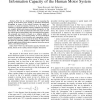Free Online Productivity Tools
i2Speak
i2Symbol
i2OCR
iTex2Img
iWeb2Print
iWeb2Shot
i2Type
iPdf2Split
iPdf2Merge
i2Bopomofo
i2Arabic
i2Style
i2Image
i2PDF
iLatex2Rtf
Sci2ools
CORR
2011
Springer
2011
Springer
An Extended Framework for Measuring the Information Capacity of the Human Motor System
—Fitts’ law is a fundamental tool in measuring the capacity of the human motor system. It measures information throughput in terms of the tradeoff between the speed and accuracy of aimed movements. However, it is, by definition, confined to prescribed stimulus-response conditions and it leaves out complex skilled performance produced irrespective of the environment. We revisit the information-theoretic basis of Fitts’ law with the goal of generalizing it into unconstrained movement. The proposed new metric is based on a subjects ability to accurately reproduce a movement pattern. It can accommodate recorded movement of any duration and composition, and involving contributions of any part(s) of the body. We demonstrate the metric by analyzing publicly available motion capture data. Possible applications include human-computer interaction, sports science, and clinical diagnosis.
| Added | 26 Aug 2011 |
| Updated | 26 Aug 2011 |
| Type | Journal |
| Year | 2011 |
| Where | CORR |
| Authors | Teemu Roos, Antti Oulasvirta |
Comments (0)

